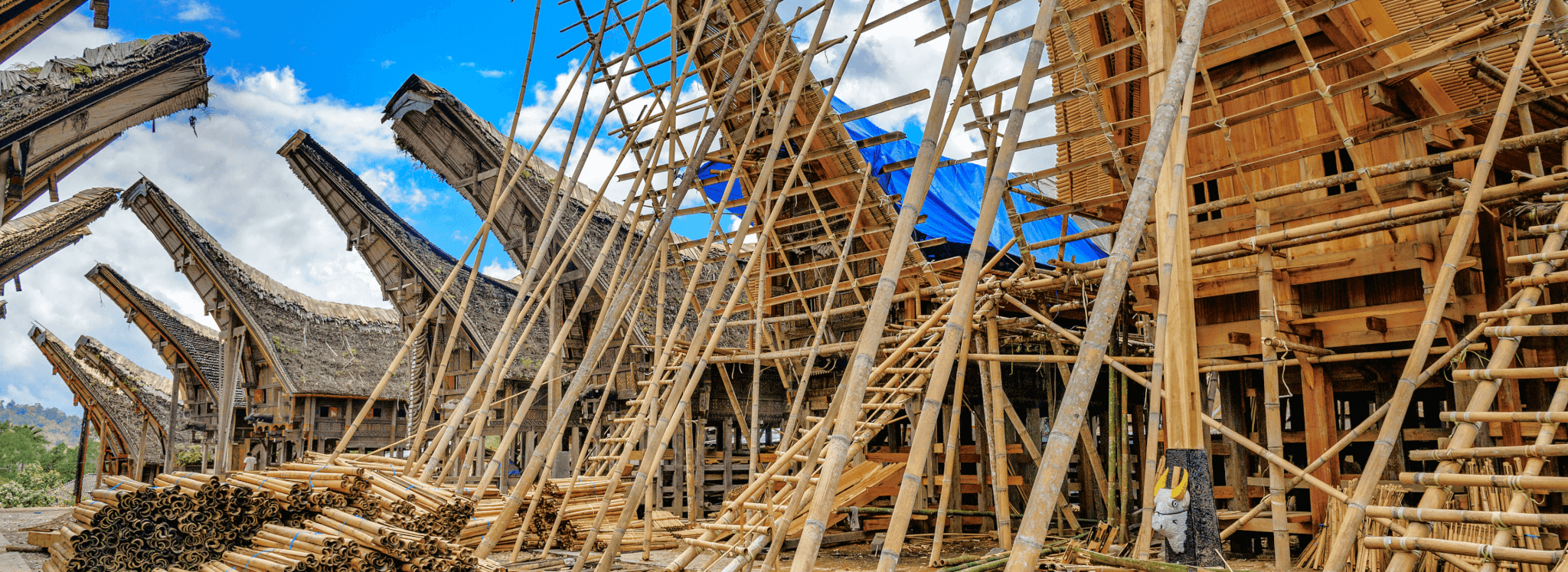
Apollonia “Apple” Cuneo joined the Industry Program at ClimateWorks for a summer internship in 2022 through the Empowering Diverse Climate Talent (EDICT) program. Here she shares reflections and learnings on the importance and promise of low-carbon building materials.
After decades of policy initiatives to make buildings more energy efficient, the embodied carbon of building materials is finally gaining more attention. Recent policy initiatives ranging from the Buy Clean California Act to President Biden’s Buy Clean Task Force could transform the production of the most carbon-intensive building materials like steel and cement, leading to dramatic reductions in greenhouse gas emissions. However, efforts to decarbonize building materials should expand to include alternative building materials like bamboo, wood, and straw. Philanthropy can play a key role in realizing the potential of these biogenic materials to decarbonize the built environment.
Building Materials
If you are reading this blog post at home, work, or school, you are probably sitting in a building made largely of cement, steel, and aluminum. These materials make up the foundation and structure for most contemporary buildings, but the production of these construction materials accounts for about 8% of the world’s annual greenhouse gas emissions. Changes in production processes and greater material efficiency are key to decarbonizing the industrial sector, but these are not the only options to reduce embodied emissions.
For millennia, people used earthen materials to build homes, businesses, and places of worship. In fact, some natural building techniques have been passed on for generations and are still used worldwide. From Portugal’s Paderne Castle to the Old Walled City of Shibam, many structures made from local materials like soil and stones have stood the test of time. These monuments to human ingenuity remind us that we can make durable, functional buildings from natural materials without warming the planet.
Efforts to decarbonize building materials should expand to include alternative building materials like bamboo, wood, and straw. Philanthropy can play a key role in realizing the potential of these biogenic materials to decarbonize the built environment.
Wood, bamboo, and straw are not novel building materials, but they are receiving renewed attention in light of recent efforts to reduce the embodied emissions of industrial products. Wood products like cross-laminated timber have an excellent strength-to-weight ratio and are widely available. Bamboo grows quickly, is relatively inexpensive, and is very sturdy. Straw is typically a byproduct of agricultural grain products like wheat and can be used for insulation. Bamboo and straw can be combined with wood to construct load-bearing walls with relatively little embodied carbon, as demonstrated by the manufacturers EcoCocon and BamCore. For example, BamCore’s biogenic walls contribute to reductions of 125 metric tons of CO2 for an average two-story home over a 70-year service life in the United States.
Biogenic materials have additional benefits. They embrace the liminal space between the indoors and outdoors, improving our mental well-being and enhancing our connection to the environment. If locally sourced, biogenic materials can foster job growth and support local economies, thereby strengthening our communities. Furthermore, when structures are designed for disassembly, biogenic materials are easily recycled and reused.
To complement other efforts that move us away from a fossil fuel-based economy, the U.S. Department of Energy committed $39 million in June 2022 for research on biogenic materials in recognition of their potential to decarbonize the industrial sector.
The Challenges of Biogenic Materials
Although wood, bamboo, and straw have positive implications for our climate and health, there are two key obstacles to their large-scale development.
First, biogenic materials must be sustainable and equitable for all species to meet the UN sustainable development goals 8, 11 and 15. The destruction of forests to satisfy a growing demand for construction materials can undermine any climate benefits of building with wood and cause significant biodiversity loss. Expanding planted wood production in Europe and Turkey, for example, is correlated with species diversity loss. Many biogenic materials require adhesives to enhance their strength and scalability, but such binders must be derived from natural materials rather than fossil fuels. The production and use of biogenic materials must be thoughtfully designed, carefully executed, and well regulated, which will help avoid risks and promote long-term environmental benefits.
Second, biogenic materials must advance social justice instead of further marginalizing frontline communities. This means that the customary land rights and resource access of Indigenous communities should be respected. Sites where building materials are grown and harvested should not consume scarce resources in ways that lead to the displacement of people or food and water insecurity. The production of biogenic materials may reinforce historical inequities if the needs of local populations are subsumed by the economic imperatives of the construction industry. For example in Southern Chile, the forest industry’s recent growth has been associated not with a reduction in unemployment or an increase in salary, but with increased poverty amongst the local populations. Local communities should be involved at all stages of production and share the benefits of biogenic buildings, with residents defining the benefits.
Philanthropy’s Role
Philanthropy can help maximize the potential of biogenic building materials and minimize their drawbacks. Specifically, funders can do the following:
- Fund research on the most promising materials, the most sustainable production pathways, and the most significant environmental justice issues.
- Support advocacy for policy initiatives that scale up research and development on biogenic materials, launch pilot projects, and establish regulations to guide production and use.
- Encourage the use of biogenic materials in historically marginalized communities, including in the Global South.
- Convene biogenic material producers, architects, engineers, contractors, and other stakeholders to strategize about scaling up production and use in climate-compatible ways that also meet environmental justice goals.
Reducing the embodied carbon in building materials requires a holistic approach that includes both creating demand for low-emissions industrial materials and scaling up the use of biogenic building components. By pairing these approaches, we can build more without baking the planet.

